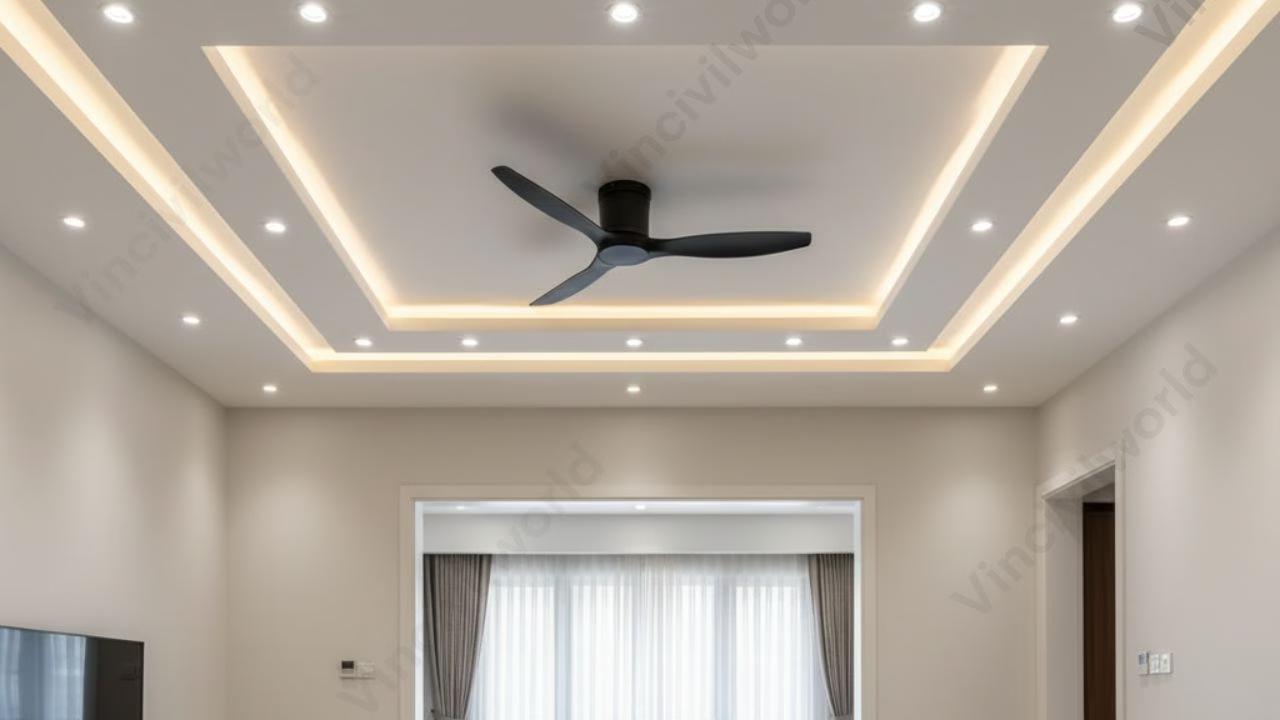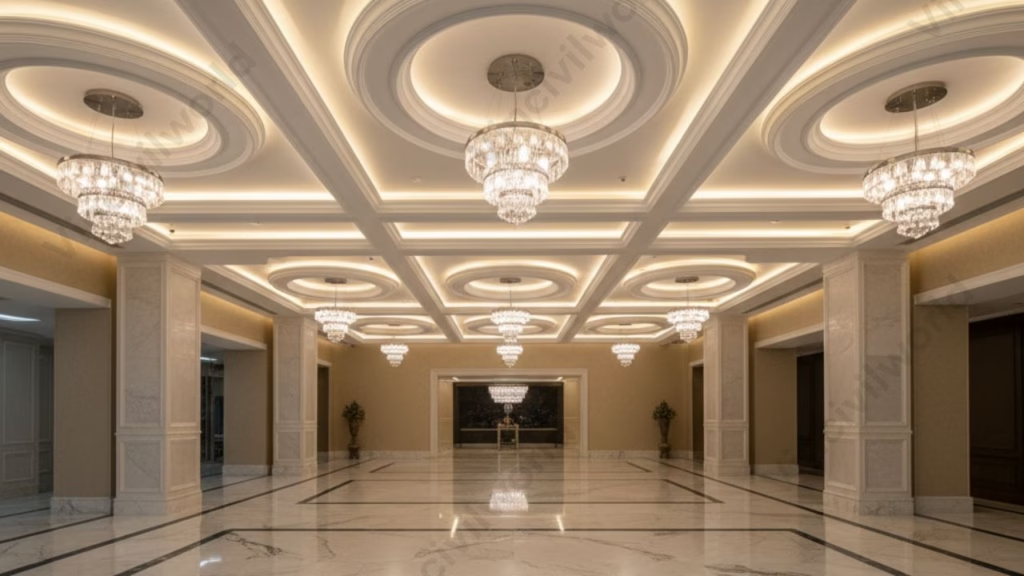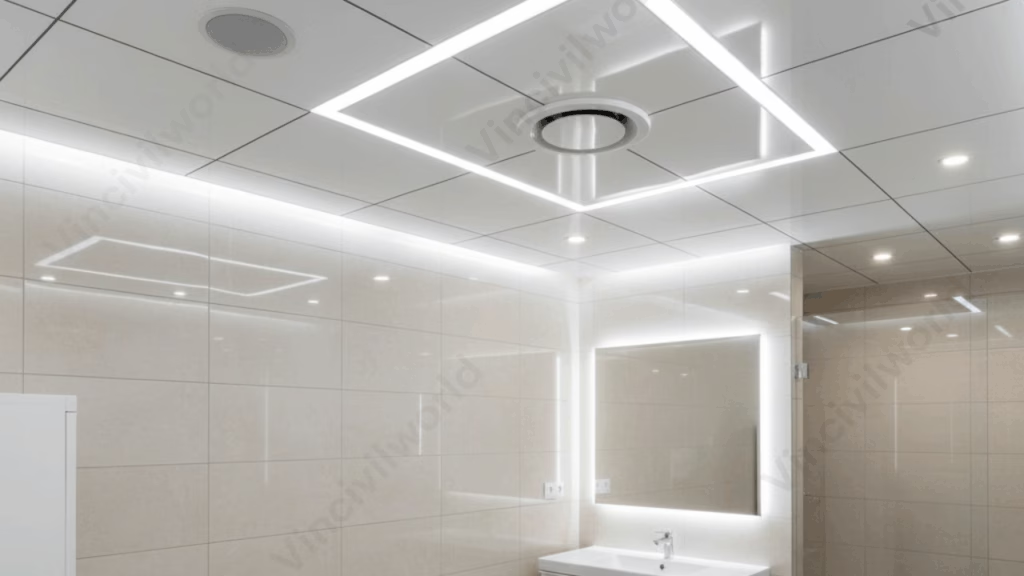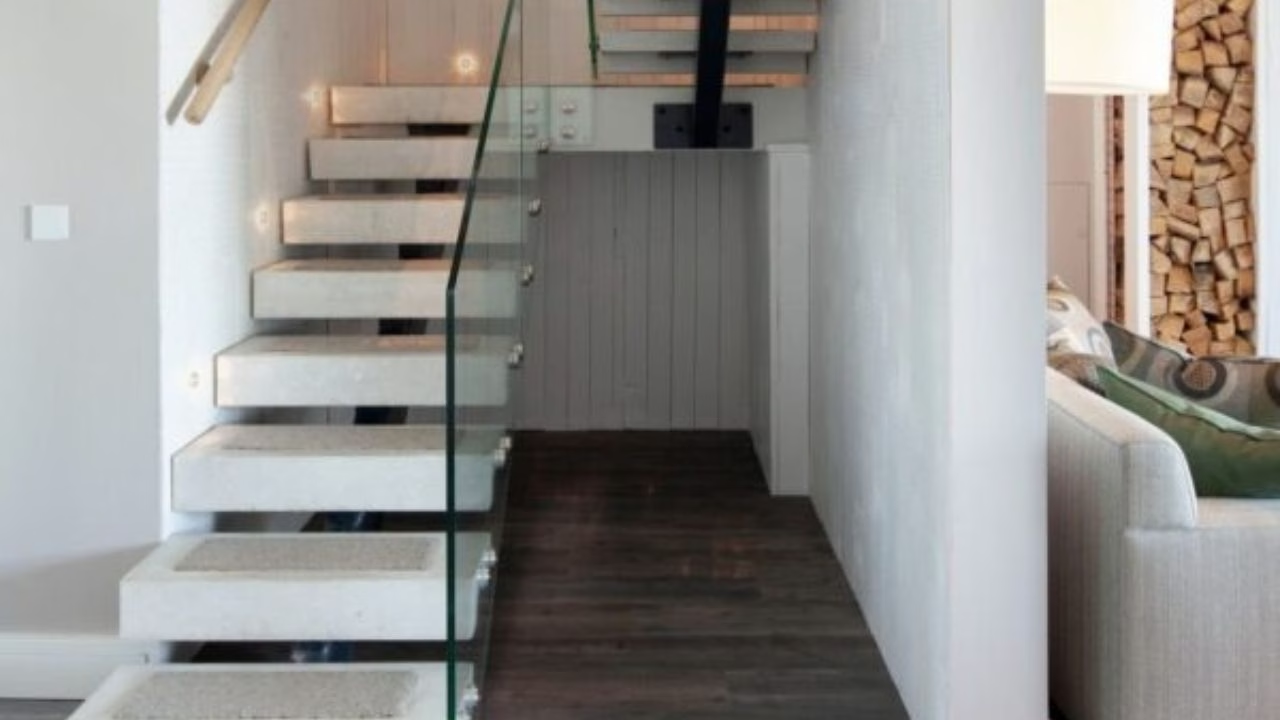Selecting the types of materials for the false ceiling is one of the tricky tasks everyone should be facing while thinking of a new construction or renovating an old one. The materials for false ceilings should be durable and be in line with the requirements of application areas.
Embarking on a renovation or new construction project often brings to light the myriad options available for every architectural element, and the false ceiling is no exception. More than just an aesthetic upgrade, a well-chosen false ceiling can dramatically impact a room’s acoustics, lighting efficiency, and overall ambiance. But with so many choices, how do you determine the best material for false ceiling that suits your specific needs and budget?
This guide aims to demystify the selection process by exploring various false ceiling types and materials. We’ll delve into the characteristics, advantages, and ideal applications of the top seven ultimate choices, giving you a clear understanding of what each offers. Beyond just aesthetics, we’ll also touch upon factors influencing the false ceiling price per square foot with material, helping you make an informed decision for your space. Let’s uncover the perfect overhead solution for your project.
An artificial ceiling below the main roof of a room or a building is known as a false ceiling. False ceilings are second layer roofs, hanging from the main roof on suspended hanger supports. False ceilings provide an attractive and aesthetically pleasing look on the roofs. This article is about the top 7 trending materials for false ceilings.
Table of contents
- Benefits of False Ceiling
- Types of Materials for False ceiling
- POP of Plaster of Paris False ceiling
- Gypsum board false ceiling
- Metal False ceiling (Tile and plant type)
- Wooden Ceiling
- PVC False Ceiling
- Mineral Fibre Board
- Disadvantages of false ceiling types and materials
- Disadvantages of false ceiling
- Installation method of all false ceilings
- Precautions For all types of False ceiling works
Benefits of False Ceiling
The main benefits of false ceilings are…
- Improves the aesthetic appearance of the interiors.
- Reduces room height proportionally and makes space feel more compact and pleasant.
- Acts as heat insulators and thereby reduces air conditioning load. The air gap between the ceiling and roof behaves like a nonconducting medium and minimises the heat and cold transmission. This reduces the air conditioning loads and energy bills.
- A false ceiling hides the air condition ducts, fire sprinkler lines, and wiring for concealed light systems. It also conceals other security systems. This setup gives an excellent look to the ceilings.
- Helps accommodating additional ceiling lights. Ceiling lights in the right places enhance ambient lighting inside the room considerably.
- Acts as an acoustic insulator and a noise reduction medium (mainly uses in auditoriums and movie halls).
- False ceiling materials are mostly fire-rated and provide fire protection.
Types of Materials for False ceiling
- POP or Plaster of Paris false ceiling
- Gypsum False ceiling
- Metal False ceiling
- Wooden False ceiling
- Mineral fibre board false ceiling
- PVC false ceiling
- Open grid False ceiling
POP of Plaster of Paris False ceiling
Plaster of Paris (POP) is the most popular and economical type of material for false ceiling works. It is preferred in residential, commercial, and industrial sectors. Plaster of Paris is a white powder obtained by calcinating gypsum. ie. heating at a high temperature to remove the water content.
Workers suspend steel grids from the roof and cover them with chicken wire mesh. They mix POP with water to form a paste, then apply it over the chicken mesh in layers, level it, and finish the surface.
POP is a very flexible, durable, and readily available material for false ceilings. It is moulded to any shape, design, and pattern. POP false ceilings are very cheap, elegant, and maintenance-free when compared to other false ceiling materials.
The main disadvantage of POP lies in the long time it takes to complete the work. It also creates an enormous amount of wastage. Housekeeping expenses will be high. Plaster of Paris could not match the factory-made superfine surface of gypsum boards. Avoid using POP in areas prone to water and moisture, as it becomes vulnerable when exposed to them.
Gypsum board false ceiling
Gypsum board is a premier and widely used surface layer material for interior works. It includes wall, ceiling, and partition systems in residential, institutional, and commercial buildings.
The gypsum panel has a non-combustible gypsum core. Specialized paper firmly bonds to and covers the surface and long edges of these panels. Workers then fix these panels on steel frames hanging from the ceiling.
They seal the joints between Gypsum boards with tapes, thereby giving the ceiling a seamless and elegant look.Apart from providing a very elegant look, they offer fire resistance and sound control. They are economical, versatile, durable, and very easy to install.
Metal False ceiling (Tile and plant type)
A false ceiling that uses metals either in the form of GALVANISED IRON, STEEL OR ALUMINIUM is called a metal false ceiling. Metal false ceilings are hard, durable and very easy to install. The ceilings are plank type (linear pattern) or grid type. Metal false ceiling tiles are easy to remove and refix after maintenance. They are economical, Maintenance-free and got high self-life when compared to other false ceiling materials.
Metal false ceilings tiles use suspended systems capable of fixing panel and grid tiles.
For more details about the Metal false ceiling please check our earlier article “ Metal false ceiling types – Clip in and Lay in tile.”

Wooden Ceiling
Wooden false ceilings are versatile, classic false ceiling materials type having a variety of natural patterns and textures. They are easy to work with and is installed using screws. Block boards with veneer surfacing are used for wooden false ceiling panels.
Wooden false ceiling is expensive because of its high material cost and higher maintenance cost. They are used in full areas or used as a highlighter. A wooden false ceiling is durable but is vulnerable to termite attacks and moisture.
PVC False Ceiling
PVC or Polyvinyl chloride ceiling is a popular and easy false ceiling option available for residential and commercial areas. These types of ceiling consists of strong, lightweight, factory-manufactured panels with a hollow core and shiny surface. Polyvinyl chloride false ceilings are strong, seamless finish and come with various designs, colours, sizes and lengths. They are very effective in resisting moisture and water. They are used for bathrooms, balconies, and other areas prone to moisture.
PVC false ceilings are reusable and durable materials that do not require any painting or polishing. They are available in pre-laminated shades and do not split, crack, wrap or rot.
Mineral Fibre Board
Mineral fibre board panels are manufactured using naturally occurring resources to recycled and processed materials. They possess excellent acoustic performance and fire resistance properties.
These types of false ceiling got a suspended T- Grid Support system like metal false ceilings. They are lightweight and easy to install the environmentally friendly product. The main disadvantage with mineral fibre is that they are brittle and breaks frequently. Mineral fibre boards are vulnerable to water and moisture and painting is not possible over the surface.
Open Grid False ceilings
Open Cell Ceiling systems comprise a series of open-cell modules designed to lay onto a suspension grid. These type of ceilings are especially useful for buildings areas lower ceilings without actually changing the roof height.
The tiles are integrated with metal ceiling support systems and plasterboard ceilings. Open cell ceilings are pleasant and can create a visually pleasing look to the room.
Open grid metal ceilings are suitable for the leisure industry, schools, offices, and corporate buildings as well as public spaces.
Disadvantages of false ceiling types and materials
- False ceiling reduces the height of the rooms. Hence installation of fans may not be possible.
- Chances of fittings falling from the ceiling.
- Ceilings may sag and de- colourise in course of time and to be replaced.
- Rodents and pests can easily enter the ceiling.
- False ceiling system may fall due to weak supports.
Disadvantages of false ceiling
- False ceiling reduces the height of the rooms. Hence installation of fans may not be possible.
- Chances of fittings falling from the ceiling.
- Ceilings may sag and de- colourise in course of time and to be replaced.
- Rodents and pests can easily enter the ceiling.
- False ceiling system may fall due to weak supports.
Installation method of all false ceilings
Checks for brickwork
The room’s walls should be perpendicular to each other. Diagonals to be checked to ensure 90 degrees of the walls.
Plastering and painting
Apply plastering up to a height of 150 mm above the false ceiling.
- Render the main ceiling and the area above the false ceiling.
- Apply a basic coat of primer before starting ceiling works.
- Complete the final painting after finishing all other work.
Check for concealed systems
- Complete all cabling and wiring for concealed systems such as ceiling lights, air conditioning, fire alarms and sprinklers, and security cameras.
- Install under-deck insulation, if required, before starting the ceiling work.
- Finish and insulate the supply and return air ducts for the air conditioning system before beginning ceiling installation.
Fixing of False ceiling
Mark the ceiling level all around the room using marking fluids. Fix the edge angle or wall angle in line with the markings. Install appropriate hangers (steel wires or steel angles) according to the ceiling system, securing them to the ceiling with anchor fasteners. Use hangers suitable for the ceiling type and manufacturer’s specifications. Hang the main grids from the hangers, ensuring that the ends of the main grids rest on the wall angle. Fix the intermediate tees or sections onto the main grid to facilitate the installation of ceiling boards or tiles.
Cut outs for fixtures
Make the cutouts for fixtures on the board as per the drawings. Provide additional members around the openings to ensure proper support for the ceiling fittings.
Precautions For all types of False ceiling works
- Check with the services drawings to ensure completion of concealed wiring works before starting ceiling works.
- Provide strong hangers well enough to handle the false ceiling load.
- Keep the center portion of the ceiling slightly higher than the outer edges to prevent sagging.
- Mark and verify the light layouts and cutout positions before making any cuts.
- Extra members if required shall be provided in case of cutting of any member coming in line with the fixtures.
- Properly seal all openings made for cable entry and ducting before installing the ceiling to restrict pests and rodents from entering the area.
Key Takeaways about the material types for false ceiling
- Selecting the right materials for false ceiling is crucial for construction and renovation projects.
- A well-chosen false ceiling enhances aesthetics, acoustics, lighting efficiency, and overall room ambiance.
- Key materials types for false ceilings include POP, gypsum, metal, wooden, PVC, mineral fibre board, and open grid types.
- Each material has unique characteristics, advantages, and ideal applications, with varying costs affecting the false ceiling price per square foot.
- False ceilings offer several benefits, such as hiding fixtures, insulation, and improved aesthetic appeal, but they also have drawbacks like reduced ceiling height and potential sagging.









